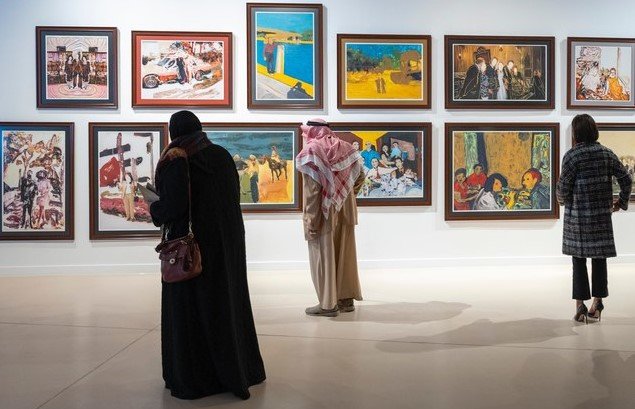In a recent interview, Mohammed Hafiz, co-founder of ATHR Gallery, discussed the rapid growth of Saudi Arabia’s contemporary art scene. He highlighted how Vision 2030 drives this cultural shift, turning challenges into opportunities for building a vibrant ecosystem in places like Jeddah, Riyadh, and AlUla.
ATHR Gallery’s Early Days and Growth
ATHR Gallery started in 2009, founded by Mohammed Hafiz and Hamza Serafi in Jeddah. At that time, the local art world moved slowly, but the founders aimed to spark new energy.
They focused on showcasing Middle Eastern and international artists. This created a space for dialogue and creativity. Over the years, the gallery expanded to Riyadh and AlUla, becoming a key player in the Kingdom’s art landscape.
Recent developments show ATHR’s role in major events. For example, it supports biennales and exhibitions that draw global attention. Hafiz notes that early efforts laid the groundwork for today’s boom.

The gallery represents artists who blend traditional and modern styles. This mix reflects Saudi culture while pushing boundaries. Visitors often praise the innovative displays that connect past and present.
Vision 2030 Fuels Art Transformation
Vision 2030, launched in 2016, aims to diversify Saudi Arabia’s economy beyond oil. Culture plays a big part in this plan, with art as a tool for global connection.
Hafiz explains that the initiative opened doors for artists and galleries. It funds projects that build infrastructure, like museums and festivals. This shift positions Saudi Arabia as a hub for contemporary art.
Key elements of Vision 2030 in the art sector include:
- Increased funding for cultural events and education.
- Partnerships with international organizations for biennales.
- Development of art districts in cities like Riyadh and AlUla.
These steps create jobs and attract tourists. Hafiz points out that young Saudis now pursue art careers, inspired by these changes.
The plan also encourages private investments. Galleries like ATHR benefit from this support, hosting shows that reach wider audiences.
Challenges in Building a Cultural Ecosystem
Creating a strong art scene from scratch brings hurdles. Hafiz admits that limited infrastructure was a big issue in the early days.
Artists faced few local opportunities before Vision 2030. Many trained abroad, but now programs keep talent at home.
Public awareness grew slowly. Hafiz recalls times when exhibitions drew small crowds. Today, events fill up quickly, showing progress.
Economic factors play a role too. Oil price changes affect funding, but diversification helps stabilize support.
Hafiz stresses the need for education. Schools now teach art history, building a knowledgeable base.
Despite setbacks, these challenges spark innovation. Galleries adapt by using digital tools for virtual tours.
Key Milestones in Saudi Contemporary Art
Saudi Arabia’s art journey includes notable achievements. These events mark the scene’s evolution.
In 1958, the first formal art exhibition happened, setting a foundation. Momentum faded, but recent years revived it.
The 2022 Contemporary Art Biennale in Diriyah drew international crowds. It featured works from global artists.
Desert X AlUla, starting in 2020, brings land art to ancient sites. The next edition is set for 2026.
Auctions by Sotheby’s in Riyadh signal market growth. A recent sale reached over 17 million dollars.
Here’s a table of major developments:
| Year | Event | Impact |
|---|---|---|
| 2009 | ATHR Gallery founded | Boosted local contemporary art |
| 2016 | Vision 2030 launch | Funded cultural projects |
| 2020 | Desert X AlUla begins | Attracted global visitors |
| 2022 | First Contemporary Art Biennale | Showcased diverse talents |
| 2025 | ATHR expansions | Strengthened art infrastructure |
These milestones show steady progress toward a thriving scene.
Opportunities for Artists and Collectors
The awakening offers chances for growth. Hafiz sees potential in nurturing local talent.
Young artists experiment with new media, like digital installations. This draws interest from collectors worldwide.
International collaborations increase. Galleries partner with events in Doha and Abu Dhabi, expanding reach.
Tourism boosts the economy. Art festivals in AlUla combine heritage with modern works, creating unique experiences.
Hafiz believes this momentum will continue. It fosters a sense of pride and identity among Saudis.
Investors find value in Saudi art. Prices rise as demand grows, making it a smart market.
Future Outlook for Saudi Art
Looking ahead, Hafiz is optimistic. He predicts more galleries and museums will open.
Vision 2030 goals include a thriving creative economy by 2030. This involves training programs and international exchanges.
Challenges remain, but opportunities outweigh them. Hafiz calls for sustained efforts to build on current successes.
The scene evolves with technology. Virtual reality could make art accessible to more people.
Hafiz envisions Saudi Arabia as a global art leader. This vision aligns with broader cultural ambitions.
What do you think about Saudi Arabia’s art rise? Share your thoughts in the comments and spread the word to friends interested in culture.
